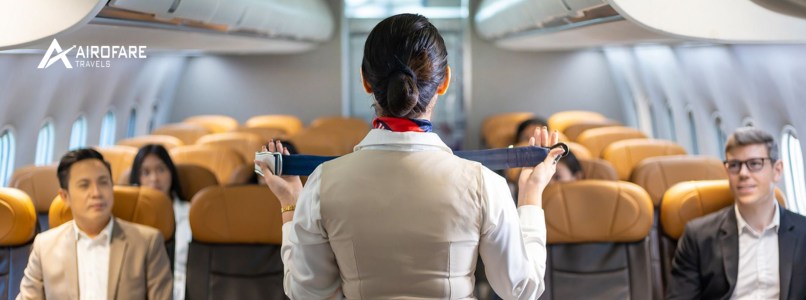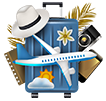Safety and Health Measures on US to India Flights
Traveling internationally, particularly on long-haul flights from the USA to India, requires careful consideration of safety and health measures to ensure a smooth and secure journey. As the world adapts to new travel norms and health protocols, airlines have implemented various strategies to protect passengers and maintain high standards of safety. This article explores the key safety and health measures in place for flights from the USA to India, helping you make informed decisions while searching for cheap flights to India and planning your travel.
Enhanced Cleaning and Sanitization
Aircraft Cleaning Protocols
Airlines have significantly ramped up their cleaning and sanitisation protocols to ensure a safe environment for passengers. This includes frequent cleaning of high-touch surfaces, such as tray tables, armrests, and seat belts, using disinfectant solutions approved by health authorities. Some airlines have also introduced advanced cleaning technologies, such as HEPA filters, which are capable of capturing a significant percentage of airborne particles, including viruses and bacteria.
Pre-Flight and In-Flight Sanitization
Before each flight, aircraft undergo thorough sanitization processes. In addition to regular cleaning routines, some airlines have implemented pre-flight fogging or spraying with antimicrobial agents to ensure comprehensive disinfection. During the flight, crew members conduct periodic cleaning of common areas to maintain hygiene standards.
Health Screening and Safety Protocols
Health Checks and Screening
Airlines and airports have introduced health screening measures to detect and prevent the spread of illness. This may include temperature checks, health questionnaires, and, in some cases, rapid testing for COVID-19 or other infectious diseases. These measures help identify potential health risks before boarding and ensure that passengers meet health and safety requirements.
Mask Mandates and Personal Protective Equipment
To minimize the risk of infection, mask-wearing is often required on flights. Passengers are generally expected to wear masks throughout the duration of the flight, except when eating or drinking. Airlines provide guidance on acceptable mask types and proper mask-wearing practices. Flight attendants are also equipped with personal protective equipment (PPE) such as masks, gloves, and face shields to protect themselves and passengers.
Social Distancing and Seating Arrangements
Social Distancing Measures
While maintaining social distancing on a plane can be challenging, airlines have implemented various measures to promote physical distancing where possible. This may include adjusting seating arrangements, reducing passenger capacity, or blocking certain seats to ensure adequate spacing between passengers. The extent of these measures can vary depending on the airline and the specific flight.
Airline Seating Policies
Some airlines have introduced flexible seating policies that allow passengers to change their seat assignments to improve social distancing. Additionally, airlines are often using advanced seating management systems to optimize seating arrangements and minimize crowding in high-traffic areas of the aircraft.
In-Flight Services and Amenities
Meal and Beverage Service Adjustments
In response to health concerns, airlines have modified their in-flight meal and beverage services. This may involve serving pre-packaged meals and drinks, reducing the number of meal services, or implementing contactless service options. These changes help minimize contact between passengers and crew members and reduce potential exposure to contaminants.
Access to In-Flight Medical Assistance
Airlines are equipped with medical kits and have trained crew members to assist with health-related issues that may arise during the flight. In-flight medical kits typically include basic first aid supplies and medications for common ailments. Additionally, some airlines have partnerships with medical services to provide remote assistance if needed.
Travel Health Tips for Passengers
Hydration and Comfort
Staying hydrated is crucial during long-haul flights to prevent dehydration and discomfort. Drink plenty of water and avoid excessive consumption of caffeinated or alcoholic beverages. Additionally, wearing comfortable clothing and moving around the cabin periodically can help reduce the risk of deep vein thrombosis (DVT) and enhance overall comfort.
Health Precautions and Personal Hygiene
Practice good personal hygiene by washing your hands regularly and using hand sanitizer with at least 60% alcohol. Avoid touching your face, and use tissues or elbows to cover coughs and sneezes. Carry personal disinfecting wipes to clean your immediate area, including tray tables and armrests.
Travel Insurance and Health Coverage
Consider purchasing travel insurance that includes health coverage to protect against unforeseen medical expenses or trip disruptions. Ensure that your insurance plan covers potential health issues related to international travel and provides support in case of emergencies.
Conclusion
Safety and health measures on flights from the USA to India have evolved to address the challenges of modern air travel. From enhanced cleaning protocols and health screenings to adjustments in in-flight services and personal protective measures, airlines are committed to ensuring the well-being of passengers. By staying informed about these measures and taking personal precautions, you can make your journey safer and more comfortable while searching for cheap flights to India and planning your travel. Whether you’re seeking affordable flights to India or simply looking to ensure a smooth trip, understanding these safety protocols is key to a successful and worry-free travel experience.







 +1-888-521-2444
+1-888-521-2444